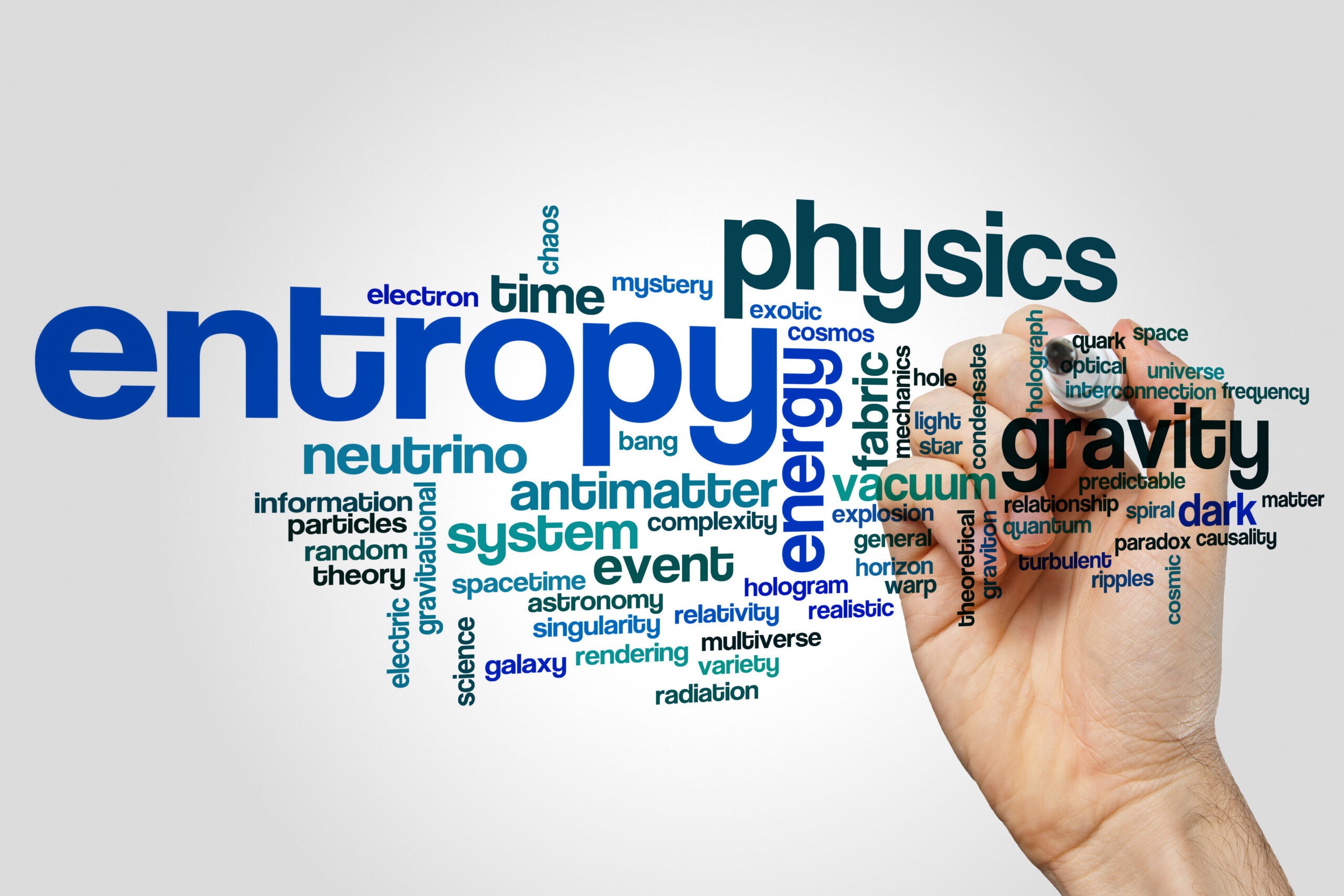DARWINISTS MISREPRESENT ENTROPY TO SAVE DARWINISM FROM COLLAPSING

NEO-DARWINISTS MISREPRESENT ENTROPY AS CLOSED VERSUS OPEN ARGUMENT, AND IGNORE INFORMATIONAL ENTROPY
CLOSED VERSUS OPEN SYSTEMS
Remarkably, Neo-Darwinists struggle to convince themselves that entropy does not apply to evolution because entropy does not operate on the planet Earth. Neo-Darwinian secularists have a huge problem with entropy—if entropy operates on planet Earth Darwinism cannot be valid. Entropy is so threatening Neo-Darwinists have developed an embarrassingly invalid argument to discount it. Atheist and author David Mills expresses the secular argument, which goes like this:
Creationists like to attach a deeply philosophical meaning to the principle of thermodynamics, which simply means “heat movement.” Quite characteristically, creationists have distorted and misapplied this scientific principle. The second law actually states that “disorder in a closed system tends to increase.” . . . Our own planet is an open system because Earth receives energy from an outside source: the sun. Without the sun’s energy, life on Earth would be impossible . . . Because Earth is an open system, receiving the sun’s radiant energy, disorder on Earth may decrease in localized spheres.[1]
His argument fails because in reality there is no such thing as a truly closed or isolated system (closed or isolated systems are merely conceptual constructs), and since entropy does not operate in an open system, then entropy would not exist if one accepts Mills’ argument. Even if you accept the closed-open claim, his argument fails because adding undirected energy to a system does not create specified information found in DNA.
Sewell comments on the “closed v. open” argument by using a tornado as an analogy. As we know, a tornado rips into town and demolishes houses and cars. Sewell thinks it intuitively impossible and astronomically improbable that a tornado can come into town and turn rubble into a house or a car. He states:
They [Darwinists] likewise must argue that, under the right conditions, tornados turning rubble into houses and cars are not really astronomically improbable, thanks to the influx of solar energy that causes tornados, and to whatever theory they have to explain constructive tornados.[2]
The second law of thermodynamics involves entropy (disorder). It states that “the entropy of the universe (or any isolated system therein) is increasing, i.e., the energy of the universe is becoming more uniformly distributed.”[3] I like to add an important element to the definition so that because of entropy “all systems devolve into a higher state of disorder unless directed energy is supplied.” This definition arises from a physics professor with whom I originally disagreed. However, after decades of observation, I realize he was absolutely right. The professor claimed every system is affected by entropy—from physical and chemical systems to interpersonal relationships.
Darwin was not oblivious to the concept of entropy and asked a fascinating as well as highly appropriate question in chapter 6 of On the Origin of Species. “Why is not all nature in confusion instead of the species being, as we see them, well defined?”[4] But once asked Darwin chose to ignore it. Darwin ignores the fact that natural selection can only act on systems that are capable of replication and therefore does not apply to origin of life. As life becomes more complex, the need for more energy and less entropy arises. Remember, the issue is complexity and organization not just more order or less disorder. Olmsted relates energy and complexity in a way we all understand is intuitively correct:
The greater the complexity of a system, the more order it entails, hence the lower the system entropy and the greater the expenditure of energy to the surroundings needed to construct it. Furthermore, the energy cost of maintaining complex systems is necessarily higher than that of maintaining simple systems. It appears that complex organisms must work harder both to replicate and to maintain themselves.[5]
Must the sun provide more energy as life becomes more complex? Mills seems to argue that if the factory machine, the empty house, the car, and interpersonal relationships had only been exposed to more sunshine all would be well. Thaxton et al. make the point that just having a source of energy is insufficient to explain the maintenance and origin of life, “the additional crucial factor is a means of converting this energy into the necessary useful work to build and maintain complex living systems from the simple biomonomers that constitute their molecular building blocks.”[6] The fact remains that everything is exposed to sunshine, and everything still falls apart, because not only do all systems require energy for creation and maintenance, but everything also requires constructive, or directed, energy.
Sewell is not alone in his disbelief of what amounts to spontaneous complexity and the origin of life. Nobel Laureate I Prigogine et al. stated:
The probability that at ordinary temperatures a macroscopic number of molecules is assembled to give rise to the highly ordered structures and to the coordinated functions characterizing living organisms is vanishingly small. The idea of spontaneous genesis of life in its present form is therefore highly improbable even on the scale of billions of years during which prebiotic evolution occurred.”[7]
Authors who claim evolution does not violate the law of entropy suspend common sense. As Sewell succinctly states, “If an increase in order is extremely improbable when a system is closed it is still extremely improbable when the system is open, unless something is entering which makes it not extremely improbable.”[8] Thaxton et al. also address this issue, “A mere appeal to open-system thermodynamics does little good. What must be done is to advance a workable theoretical model of how the available energy can be coupled to do the required work.”[9]
INFORMATIONAL ENTROPY
Information in biological systems resides in DNA and is a direct result of specified nucleotide sequence. The sequential order is crucial for the chains of amino acids to fold in the correct three-dimensional structures to properly perform their intended functions.[10] The central dogma in genetics is DNA to RNA to proteins. An incorrect nucleotide sequence results in protein malfunction—disease, disability, or death. Information is not a matter of order but of complexity. As Orgel states, “Living organisms are distinguished by their specified complexity.”[11]
Information exhibits causal control over biomolecular function. Miller coins the term “control information” because nucleotide sequences in DNA direct the acquisition and use of matter and energy to enable biological functions.[12] Energy must be coupled to work or it is useless. Neo-Darwinists have provided no example of how energy flow through a system achieves configurational entropy of work that is required to create a system capable of replicating itself.[13] Thaxton et al., describe the problem facing Neo-Darwinists:
We must not forget the total work to create a living system goes far beyond the work to create DNA and protein . . . an estimated minimum of 20 to hundreds of proteins as well as DNA and RNA are required to make even a simple replicating system. The lack of known energy-coupling means to do the configurational entropy work required to make DNA and protein is many times more crucial in making a living system. As a result, appeals to chance for this most difficult problem still appear in the literature in spite of the fact that calculations give staggeringly low probabilities, even on the scale of 5 billion years.[14]
The problem of coupling energy to do specified work and decrease configurational entropy of information cannot be solved by a mere appeal to open-system thermodynamics.[15] The following rather long paragraph gives one a sense of the insurmountable problems Neo-Darwinists face:
Compounding the problem, proteins have a limited lifespan, so they must constantly be replaced. Proteins do not self-replicate, and RNAs are too unstable for long-term information storage. Therefore, the minimal requirements for a cell must include the protein sequences being encoded into DNA, and the cell must possess the DNA-protein translational machinery to access the encoded information and implement it in the manufacture of new proteins. In addition, a functional metabolism requires the cell to tightly control each reaction using feedback lops, and this meticulous coordination is to a large extent accomplished through the regulation of the genes through gene-specific promoter, operator, and enhancer regions. They direct the timing and quantities of proteins manufactured.[16]
CONCLUSION
This essay has demonstrated that Neo-Darwinists ignore the reality that undirected energy cannot create or maintain life. Energy must be coupled with work to create information. The adjectives used in this essay in describing energy, information and work attest to an unavoidable complexity ignored by Darwinists: energy (directed, coupled, constructive), information (specified, control, configurational), and work (coupling, specified).
The argument that the sun shining on the Earth solves the problems of structural and informational complexity is an argument from ignorance. Darwinists have the burden of proving their theory. To date none have been able to deliver nor will they ever deliver if they continue to ignore work and information that are necessary components of the energy and entropy of biological systems.
[1] David Mills, Atheist Universe: The Thinking Person’s Answer to Christian Fundamentalism (Berkeley: Ulysses Press, 2006), 128.
[2] Granville Sewell, “Entropy and Evolution,” Bio-Complexity 2013 (2) 1-5, 5.
[3] Charles Thaxton, Walter Bradley, Roger Olsen, James Tour, Stephen Meyer, Jonathan Wells, Guillermo Gonzalez, Brian Miller and David Klinghoffer, The Mystery of Life’s Origin: The Continuing Controversy (Seattle: Discovery Institute Press, 2020), 171.
[4] Charles Darwin, On the Origin of Species: The Illustrated Edition, David Quammen (New York: Sterling Publishing, 2011), 191.
[5] John Olmsted III, “Observations on Evolution,” in Entropy Information and Evolution: New Perspectives on Physical and biological Evolution, ed. Bruce Weber, David Depew and James Smith (Palatino: MIT Press, 1990), 256.
[6] Thaxton, 181.
[7] Ilya Prigogine, Gregoire Nicolis, and Agnes Babloyantz, “Thermodynamics of Evolution,” Physics Today 25, no. 11 (1972): 23, doi: 10.1063/1.3071090.
[8] Granville Sewell, “Entropy, Evolution and Open Systems,” in Biological Information: New Perspectives, ed. Robert Marks II, Michael Behe, William Dembski, Bruce Gordon, and John Sanford (Singapore: World Scientific, 2013), 174.
[9] Thaxton, 203.
[10] Id. 366.
[11] L. E. Orgel, The Origins of Life (New York: John Wiley, 1973, 189ff; from Thaxton, 188.
[12] Thaxton, 366.
[13] Id., 214
[14] Id., 225.
[15] Id., 203.
[16] Id., 368.

Leave a Reply